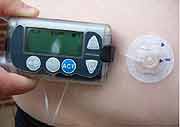
THURSDAY, Feb. 3 (HealthDay News) — While the causes of type 1 diabetes aren’t known for certain, a new analysis backs the possibility that cold-like viruses might trigger the disease.
Australian researchers looked at a number of studies, and concluded there is a strong association between enteroviruses and the development of type 1 diabetes. In fact, children with diabetes were 10 times more likely to have had an enterovirus infection than children without the disease.
“The finding implies that enterovirus infection is a very important cause of type 1 diabetes,” said lead researcher Dr. Maria Craig, an associate professor at Children’s Hospital at Westmead’s Institute of Endocrinology and Diabetes in Sydney.
Craig noted that the idea that enteroviruses are involved in the development of type 1 diabetes is not new, but this study makes use of new data that makes the association more likely.
“It is time to look at how these viruses are involved in the disease process,” Craig said. The goal would be to find a way to “stop these viruses from contributing to diabetes — potentially leading to vaccination,” she added.
The report is published in the Feb. 3 online edition of the BMJ.
For the study, Craig’s team, using a type of research known as a meta-analysis, reviewed 24 papers and two abstracts involving 4,448 individuals to see if there was an association between type 1 diabetes and enterovirus infection.
The data suggested a strong association, especially among children, Craig said.
Type 1 diabetes is caused by a combination of genetic factors, the immune system and environmental factors, the researchers explained. And enteroviruses are common viruses in infants and children. Enteroviruses can cause cold or flu symptoms, fever, muscle aches, rash or even meningitis, they noted.
Recently, there has been a worldwide increase in the incidence of childhood type 1 diabetes, especially in children under 5, which could be partially because of more exposure to these viruses, the researchers suggested.
Dr. Didier Hober, a professor of virology at University Lille in France and author of an accompanying journal editorial, said “the increased incidence rate of type 1 diabetes can be explained by a role of environmental factors, especially enteroviruses, like coxsackievirus B.”
However, it is unclear whether enteroviruses are involved in all patients or just some, he added. “Enteroviruses could act as inducers of the disease or as accelerators of the progression of the disease. A persistent infection or consecutive infections could play a role,” he said.
“The relationship between enteroviruses and type 1 diabetes opens up the possibility of developing new preventive and therapeutic strategies to fight the disease,” Hober said.
Another expert, Dr. Joel Zonszein, a professor of clinical medicine at the Albert Einstein College of Medicine’s Clinical Diabetes Center at Montefiore Medical Center in New York City, said for 40 to 50 years it has been proposed that these viruses may trigger type 1 diabetes.
“There is an association,” he said. “It doesn’t show a cause-and-effect; it shows an association. Maybe patients with type 1 diabetes are more susceptible to get these enteroviruses.”
“It’s a good reminder that we don’t know the causes of type 1 diabetes,” he added.
Type 1 diabetes occurs when the body cannot produce insulin, which is essential in metabolizing sugar. The resulting extra sugar in the blood can cause serious complications, such as heart disease, kidney disease, loss of sight or limbs and an early death. The condition is controlled with doses of insulin and a diet that keep blood sugar levels in normal ranges.
In Type 2 diabetes, which is far more common, the body produces insulin but doesn’t utilize it properly. Unlike type 1 diabetes, type 2 is linked to overeating and under-exercising.
More information
For more on type 1 diabetes, visit the U.S. National Library of Medicine.

